Sizes of plastic pipes for sewage: gost and real range
What sizes of plastic sewer pipes are stipulated by the current regulatory documents? For what purpose are pipes of various sizes used? Which of the plastics offered by the modern market is preferable?
Let's figure it out.
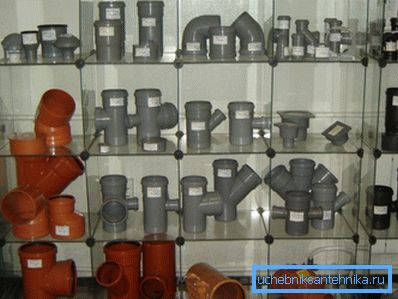
Types of plastics
To begin with, what, in fact, are plastic pipes for sewage systems.
The list is small:
- Non-plasticized polyvinyl chloride (NPVH, more often - just PVC) - the undoubted leader in terms of production;
- Somewhat less can be found in the sale of sewage made of polypropylene;
- Polyethylene is an outsider: not every store will offer it to you.
How does the price of these materials? Let's take as a sample a very running tube 2 meters long and 110 mm in diameter.
| Material | Cost of |
| Polypropylene | 270 rubles |
| PVC | 250 rubles |
| Polyethylene | 320 rubles |
Nuance: the comparison is not entirely correct. The pipes involved in it differ in wall thickness, which affects the cost of production.
What is the practical difference between different plastics?
Which one should I choose when installing the sewage with my own hands?
- Polypropylene is more wear-resistant, harder and, with equal wall thickness, has a greater ring stiffness than competing solutions.
- Polyethylene is more elastic and perfectly dampens acoustic vibrations. Breaking such a pipe is almost impossible; bends are permissible during installation, destructive for other plastics. The downside is lower resistance to high temperatures.

Regulations
Now let's see what lengths and diameters of sewage plastic pipes are laid down in the current regulatory documents.
GOST 22689.2-89
This GOST produces polyethylene pipes and fittings.
We, of course, are primarily interested in size.
- Pipes are available in straight lengths of 8, 6, 5.5, 3 and 2 meters.
- Wall thickness varies from 2 to 5.2 millimeters.
- The table of diameters of plastic sewer pipes, frankly, does not strike with a wealth of choice. There are four sizes in the list: 40, 50, 90 and 110 millimeters.
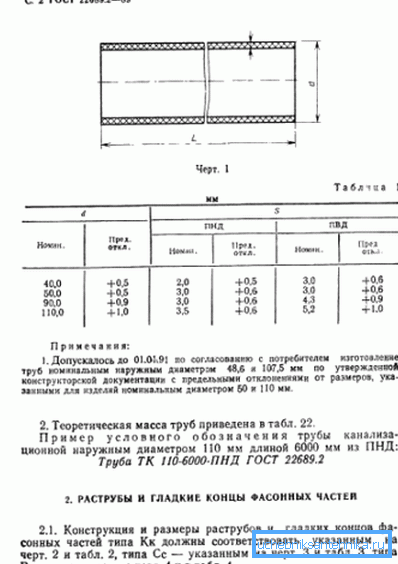
TU 4926-002-88742502-00
Polypropylene products are not manufactured according to GOST, but according to specifications. What do the current TUs say?
The list of possible lengths of straight segments will seem familiar to us: 8, 6, 5.5, 3 and 2 meters.
However: in coordination with the customer it is possible to make pipes of other length. The minimum and maximum values are not limited, but common sense dictates that it is extremely inconvenient to transport stretches of more than 12 meters in length by any existing transport.
The diameters of plastic sewer pipes and the thickness of their walls can take the following values:
| Diameter, mm | Wall thickness mm |
| 50 | 3.0 |
| 110 | 3.5 |
| 150 | 5.4 |
PVC
With PVC the situation is quite comical.
As a regulatory document regulating the production, the sellers indicate:
- GOST 1898-2001, no signs of which were not freely available. No, the author does not claim that this standard does not exist; but not a single certificate of conformity on the websites of manufacturers and dealers either.
- GOST R 51613-2000 relating to pressure pipes. Of course, nothing prevents the use of a pressure pipe with a flare connection for free-flow sewage; however, the goods produced according to this standard will obviously be more expensive: greater strength means greater wall thickness.
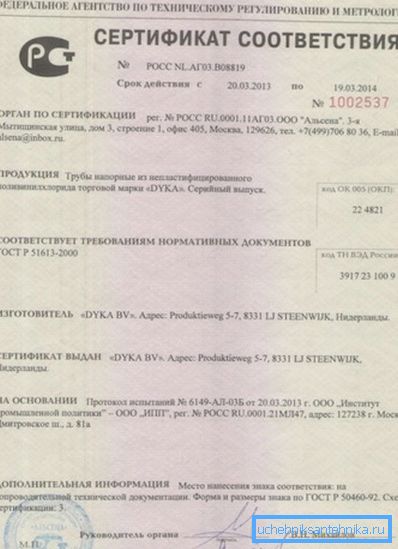
- In addition, departmental construction standards VSN 48-96 give the dimensions of plastic sewage pipes for the internal engineering networks of residential and public buildings.. Fortunately, at least in this document real, genuine bell-shaped non-pressure pipes from NPVH are mentioned.
Let's examine the documents.
GOST R 51613-2000
- Pipes are produced in straight lengths from 4 to 12 meters with a multiplicity of 0.25 m (4.0, 4.25, 4.50, and so on).
- Wall thickness varies from 1.5 to 23.2 mm.
- Diameter can take values from 10 to 315 mm. Values of 50, 90, 110, 150 and 200 mm are present, indicating that the pipes are compatible with the pipe fitting for free-flow sewage.

BCH 48-96
When studying this document we are waiting for another surprise. It, among other things, contains a procurement manual recommending the products of a very specific manufacturer - OAO NPO Plastic. The size list does not describe the requirements for the products produced, but. range of items to be purchased.
Well, and that bread.
We give this information in full, without bills:
- The lengths of the pipes and nozzles are 345, 360, 370, 410, 450, 457, 465, 515, 535, 870, 970, 1125, 1215, 1255, 1315, 1500, 2000, 2485, 2605, 2620, 2650, 4000 and 5240 mm Judging by the size, we are talking about ordering for several very specific projects of houses.
- The used diameter of plastic pipes for sewage is quite traditional for internal networks - 50, 90 and 110 millimeters.
Meanwhile in the real world
Dear reader, are you confused? Let me free you from the captivity of illusions and acquaint you with a real assortment of a pair of companies specializing in the production of sewage.
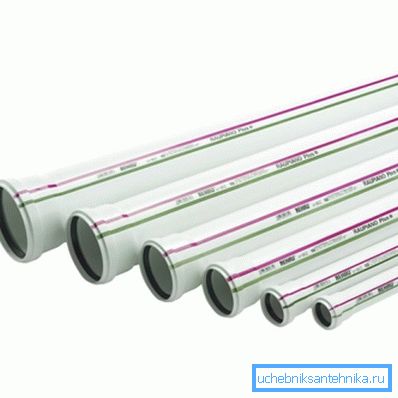
Here is the range of products manufactured by AquaMaster Group companies from unplasticized polyvinyl chloride.
| Diameter, mm | Wall thickness mm | ||
| Lungs | Average | Heavy | |
| 110 | - | - | 3.2 |
| 160 | 3.2 | 4.0 | 4.7 |
| 200 | 3.9 | 4.9 | 5.9 |
| 250 | 4.9 | 6.2 | 7.3 |
| 315 | 6.2 | 7.7 | 9.2 |
| 400 | 7.9 | 9.8 | 11.7 |
| 500 | 9.8 | 12.3 | 14.6 |
But the list of diameters of polyethylene pipes Korsis Plus, used in the construction of sewers:
- 1200,
- 1400
- 1600,
- 2000,
- 2200,
- 2600 mm.
Curiously: the structure of these pipes is very different from the usual to us. Suffice it to say that they are double-layered, with corrugated outer and smooth inner layers.
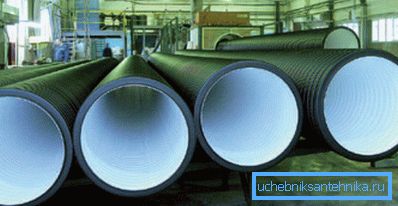
Areas of use
Finally, let's find out where sewers of various diameters are used.
Diameter 50 mm used to connect all sanitary appliances, except the toilet. In addition, in the houses of some projects, this diameter mounted kitchen drain pipes.
90 mm are used when connecting certain types of toilet bowls (first of all - flush mounting).
110 mm - the most popular standard size: from connecting a toilet bowl to laying of risers and even plank beds uniting several risers.
150 - 200 mm used when laying releases to the well in apartment buildings.
250 - 600 mm - pipes connecting wells sewage.
600 and above - collectors that collect wastewater from entire areas.
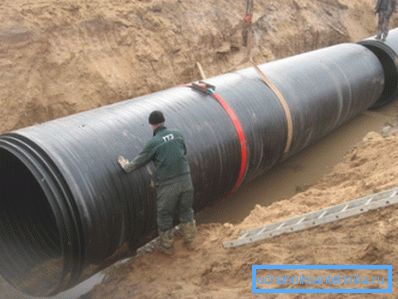
Conclusion
We hope that our insight into the dark secrets of existing regulatory documents and their complex relationship with real production will be useful to the reader. As usual, additional information can be found in the video in this article.
Successes!